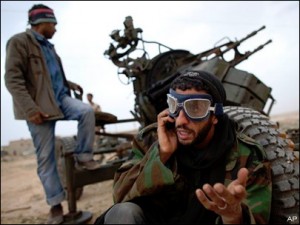Rebels Hack Libya's Comm Network
 The Wall Street Journal reports:
The Wall Street Journal reports:
A team led by a Libyan-American telecom executive has helped rebels hijack Col. Moammar Gadhafi's cellphone network and re-establish their own communications.
The new network, first plotted on an airplane napkin and assembled with the help of oil-rich Arab nations, is giving more than two million Libyans their first connections to each other and the outside world after Col. Gadhafi cut off their telephone and Internet service about a month ago.
A team led by a Libyan-American telecom executive has helped rebels hijack Col. Moammar Gadhafi's cellphone network and re-establish their own communications.
The new network, first plotted on an airplane napkin and assembled with the help of oil-rich Arab nations, is giving more than two million Libyans their first connections to each other and the outside world after Col. Gadhafi cut off their telephone and Internet service about a month ago.
Ousama Abushagur, a 31-year-old Libyan telecom executive raised in Huntsville, Ala., masterminded the operation from his home in Abu Dhabi. Mr. Abushagur and two childhood friends working as corporate managers in Dubai and Doha started fund-raising on Feb. 17 to support the political protests that were emerging in Libya. By Feb. 23, when fighting had erupted, his team delivered the first of multiple humanitarian aid convoys to eastern Libya.
But while in Libya, they found their cellphones and Thuraya satellite phones jammed or out of commission, making planning and logistics challenging.
Security was also an issue. Col. Gadhafi had built his telecommunications infrastructure to fan out from Tripoli—routing all calls through the capital and giving him and his intelligence agents full control over phones and Internet.
On March 6, during a flight back to the United Arab Emirates after organizing a naval convoy to the embattled city of Misrata, Mr. Abushagur says he drew up a diagram on the back of a napkin for a plan to infiltrate Libyana, pirate the signal and carve out a network free of Tripoli's control.
What followed was a race against time to solve the technical, engineering and legal challenges before the nascent rebel-led governing authority was crushed under the weight of Col. Gadhafi's better-equipped forces. After a week of victories in which the rebels swept westward from Benghazi toward Col. Gadhafi's hometown of Sirte, the rebel advance stalled and reversed on March 17, when the United Nations approved a no-fly zone and government forces kicked off a fierce counterattack.
In a sign of deepening ties between Arab governments and the Benghazi-based administration, the U.A.E. and Qatar provided diplomatic support and helped buy the several million dollars of telecommunications equipment needed in Benghazi, according to members of the Libyan transitional authority and people familiar with the situation.
Meanwhile, rebel military commanders were using flags to signal with their troops, a throw-back that proved disastrous to their attempts at holding their front lines.
"We went to fight with flags: Yellow meant retreat, green meant advance," said Gen. Ahmed al-Ghatrani, a rebel commander in Benghazi. "Gadhafi forced us back to the stone age."
Click here to read more.

